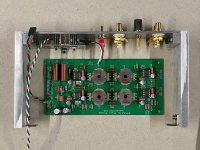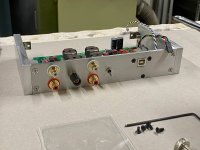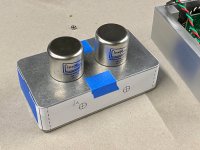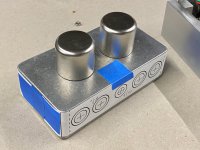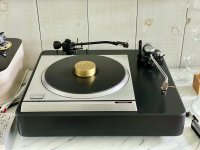I am considering building Pete Millett's phono in the link below.
LR Phono Preamp
I did a search here, but only found a swap meet add.
I am seeking comment from anyone that has built or listened to this design.
Thanks in advance
Edit, realized this maybe.wrong forum, mods feel free to move
LR Phono Preamp
I did a search here, but only found a swap meet add.
I am seeking comment from anyone that has built or listened to this design.
Thanks in advance
Edit, realized this maybe.wrong forum, mods feel free to move
Last edited:
@mr ed. Did you ever build this? ... Here's mine in progress, along with the 2 arm plinth recently fabbed, upgrading from my single arm one, and a SUT head unit. Phono will be battery powered (silent swticher). My other phono amps.
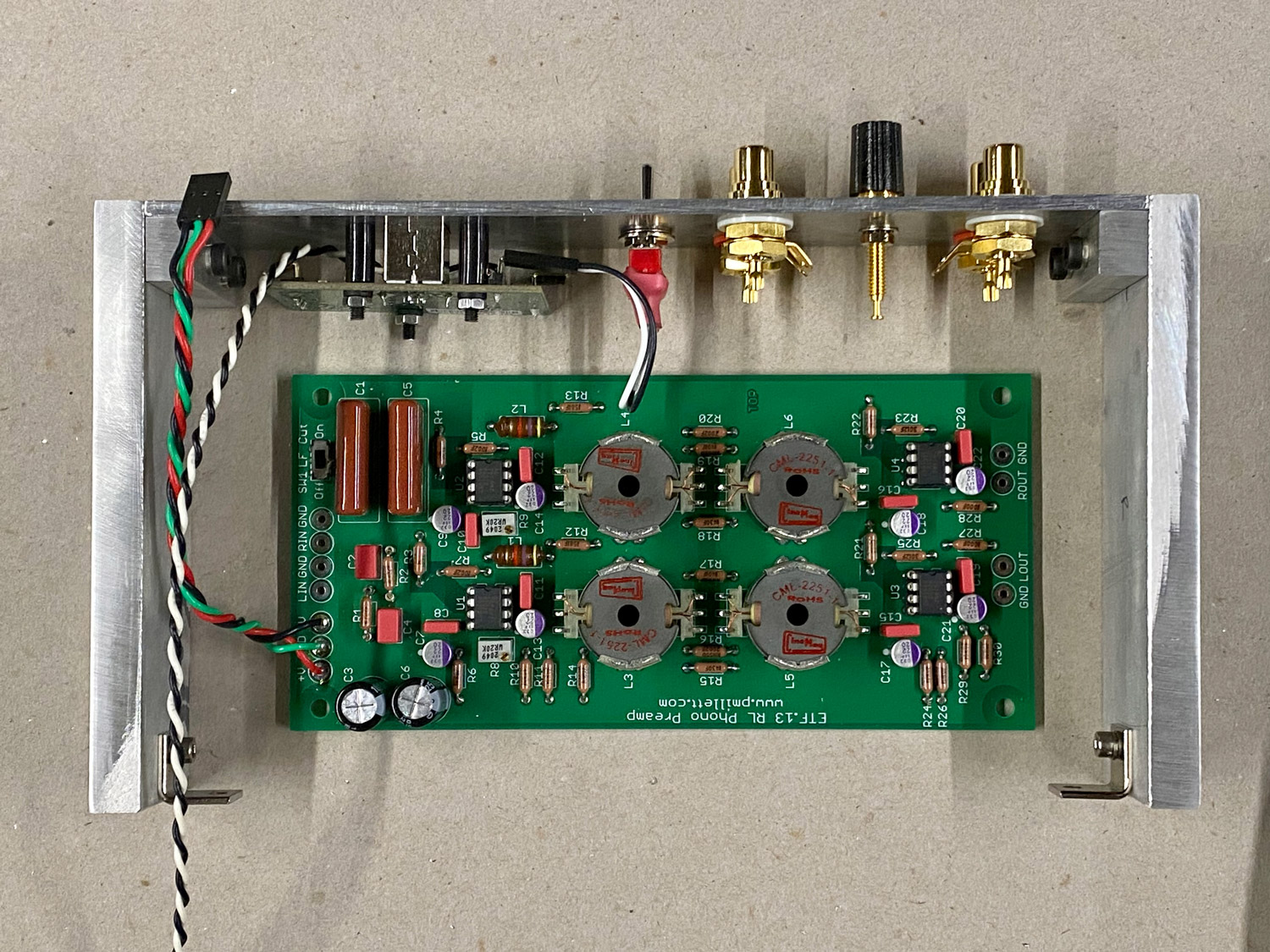
Attachments
100%? I’m very trusting.. Pete’s instructions do say open…or rather “no input signal”… I sent him an email about it.. I can’t find any errors on the board or suspect joints. Also for fun I did feed it some music and saw some DC bouncing around on the outs.. more learning here to do for sure…
AD797's on the input for a MM cartridge phono-amp? Sounds like someone doesn't understand the importance of low current noise in a MM phono amp. I make that equiv to about 32nV/√Hz at 5kHz for a 1k+0.5H MM winding. An NE5534A would manage 8nV/√Hz, about 12dB quieter at that frequency (less hiss).
With 0.5H the current noise will dominate till below 300Hz or so for an AD797, then the source resistance dominates - the ultra low voltage noise
of the chip does approximately nothing across the entire spectrum. With 1k source resistance even 3nV/√Hz is going to be mainly swamped by Johnson noise from the cartridge - choosing a very expensive 0.9nV part isn't logical.
The time a low voltage-noise chip like the AD797 shines is for a low impedance input like an MC cartridge.
MM cartridges have many 1000's of turns and thus loads of inductance (typically close to 1 henry) to boost their impedance at higher frequencies. They are high impedance sources.
On reflection their might be justification for extra low voltage noise parts - which is that the 1/f noise is going to be less for a given frequency, so you could get some benefit at 100Hz and below, but generally higher frequency noise is more intrusive.
With 0.5H the current noise will dominate till below 300Hz or so for an AD797, then the source resistance dominates - the ultra low voltage noise
of the chip does approximately nothing across the entire spectrum. With 1k source resistance even 3nV/√Hz is going to be mainly swamped by Johnson noise from the cartridge - choosing a very expensive 0.9nV part isn't logical.
The time a low voltage-noise chip like the AD797 shines is for a low impedance input like an MC cartridge.
MM cartridges have many 1000's of turns and thus loads of inductance (typically close to 1 henry) to boost their impedance at higher frequencies. They are high impedance sources.
On reflection their might be justification for extra low voltage noise parts - which is that the 1/f noise is going to be less for a given frequency, so you could get some benefit at 100Hz and below, but generally higher frequency noise is more intrusive.
Last edited:
Not sure what to do with most of what was written… bears further research and understanding on my part. I certainly never claimed to understand anything at all. “Trying” being the operative part of my personal existence, but I digress.
I’m feeding the stage with a LOMC cart, into some cinemag SUTs w/ switchable ratios, then to LR phono. I’ll plug an arm/cart into the board and see if I can null the DC on the outs, for curiosities sake, and maybe that’s the ticket…
I’m feeding the stage with a LOMC cart, into some cinemag SUTs w/ switchable ratios, then to LR phono. I’ll plug an arm/cart into the board and see if I can null the DC on the outs, for curiosities sake, and maybe that’s the ticket…
Well...an update... plugged in an arm as suggested here... and zeroed the DC no problem. (was able to zero w inputs shorted from the get go—just confused by Pete's instructions as mentioned.) Unplugged the arm and DC is almost 14V, fwiw. So, note to self, I suppose. I'll report back with some pics when the chassis and SUT box is finished and I've had a listen...waiting on some materials. Thanks for suggestions guys!
Yes, its a DC coupled amp with over 60dB of DC gain... Unplug the input and the only route for the large bias current of the AD797 is through the 47k load resistor, and this offset voltage then gets multiplied by over 1000.Unplugged the arm and DC is almost 14V, fwiw.
Another reason the AD797 is a poor choice here - a JFET input opamp would be sensible and give low DC offsets so that plugging/unplugging is less likely to put your speaker cones in orbit.
The fact there's no rumble filtering at all is disappointing really - this is pretty much essential for a real-world phono amp as high volume subsonic levels are never good news for speakers and amps.
Did you actually study the schematic Mark?
I see an option for 20 Hz LF cut off...
First opamp has gain of 20 dB and 47k load resistor; second opamp has gain of 41 dB and load of 1k4. Net gain is 40 dB because RIAA correction takes away 20 dB.
Is your assumption of offset multiplication by 1000 at the input opamp correct?
I see an option for 20 Hz LF cut off...
First opamp has gain of 20 dB and 47k load resistor; second opamp has gain of 41 dB and load of 1k4. Net gain is 40 dB because RIAA correction takes away 20 dB.
Is your assumption of offset multiplication by 1000 at the input opamp correct?
How about if anyone has listened to it? Pretty much in every walk of life in my experience, rarely does an analysis of anything make up for actual experience of the thing at hand (though I do understand what @daanve is talking about). Sure, a good look with no practical experience can be super informative..but it's never the full story of anything IMHO and may even keep some cool discoveries from making their way into your purview. Now, that's not to suggest that the listening impressions from anyone may be meaningless to me—since we aren't using the same carts, speakers, room... but it's fun to talk about anyway.
As mentioned my other 2 phono pres are these from Salas. Both FSP and UltraFSP—perhaps the tip of the spear by some accounts. By comparison Pete's circuit is different even to my non-electrically designed eyes (I also just like his projects in general). It's an opportunity to learn some more stuff, listen to more stuff—and mess about with the Silent Switcher and batteries.
My SUT box is almost complete...I'll probably have this project online by the weekend for some listening.
As mentioned my other 2 phono pres are these from Salas. Both FSP and UltraFSP—perhaps the tip of the spear by some accounts. By comparison Pete's circuit is different even to my non-electrically designed eyes (I also just like his projects in general). It's an opportunity to learn some more stuff, listen to more stuff—and mess about with the Silent Switcher and batteries.
My SUT box is almost complete...I'll probably have this project online by the weekend for some listening.
I have built 3 of these and really like the sound. Very clear with good soundstage . I also have a couple Pearl II and Salas Folded. All 3 are very good and very comparable to my ears. Petes discussion of LR design (document is on his website) is well worth the effort to read. I definitely recommend this phono section.
Whoops, yes I didn't spot that, but if its not used my analysis explains the horrendous ~14V DC output offset when the cartridge is disconnected.Did you actually study the schematic Mark?
I see an option for 20 Hz LF cut off...
The DC gain is 61dB therefore with no LF cut, and 41dB with LF cut.First opamp has gain of 20 dB and 47k load resistor; second opamp has gain of 41 dB and load of 1k4. Net gain is 40 dB because RIAA correction takes away 20 dB.
Is your assumption of offset multiplication by 1000 at the input opamp correct?
The AD797 bias current is about 0.25µA, which is 12mV across 47k resistor.
12mV +61dB = 13.5V,
12mV +41dB = 1.35V
Both are horrendous transients when unplugging a cartridge, but I guess if you use RCA connectors you are used to this with the ground disconnecting first (!).
If your power amp is DC-coupled this sort of DC offset is of genuine concern.
I have built 3 of these and really like the sound. Very clear with good soundstage . I also have a couple Pearl II and Salas Folded. All 3 are very good and very comparable to my ears. Petes discussion of LR design (document is on his website) is well worth the effort to read. I definitely recommend this phono section.
Thanks. I've read Pete's paper on LR—ingested what I could—definitely good reading.
I'll play with the LF switch....
BTW if the AD797's are socketed then OPA827 might be a suitable pin-compatible JFET replacement part.
Shame its a single opamp in DIP, dual opamps are much more plentiful and typically cheaper, a single OPA1652 would replace 2 AD797's at a fraction of the cost with probable noise improvements and definitely fix the DC-offset issue.
Shame its a single opamp in DIP, dual opamps are much more plentiful and typically cheaper, a single OPA1652 would replace 2 AD797's at a fraction of the cost with probable noise improvements and definitely fix the DC-offset issue.
...why then were AD797's (very expensive) chosen over NE5534A's in the first place?
If it costs more, it has got to be better.
However when AD797 production gets as high as NE5534, it too will come down in price like the TDA1034/'5534 did since before 1979(!). Then we will have to turn to something more expensive.
Origins of the 5534- DIYaudio
NE5532 - Wikipedia
Last edited:
- Home
- Source & Line
- Analogue Source
- Pete Millett LR phono
